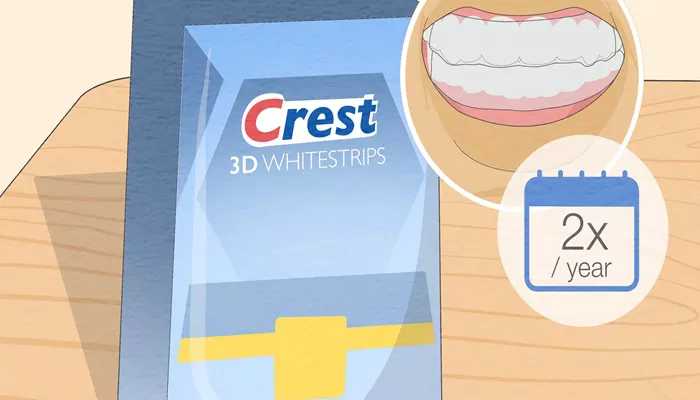Teeth whitening strips are a popular cosmetic treatment for those seeking a brighter smile. Crest whitening strips, in particular, are widely used for their convenience and effectiveness. However, some users experience discomfort or pain after using these products. This article delves into the reasons why teeth might hurt after using Crest whitening strips, explores potential underlying dental issues, and offers advice on how to mitigate these effects.
Understanding Crest Whitening Strips
Crest whitening strips are thin, flexible strips coated with a whitening gel that contains hydrogen peroxide or carbamide peroxide. These ingredients are designed to break down stains on the teeth and lighten their color. The strips are applied directly to the teeth and typically left on for a specified duration before being removed. While effective for many, some users report experiencing discomfort or pain after use.
Common Causes of Pain After Using Crest Whitening Strips
Tooth Sensitivity
Tooth sensitivity is one of the most common side effects reported by users of whitening products. This sensitivity occurs when the whitening agents in the strips penetrate the enamel and reach the dentin, the layer of the tooth that contains nerve endings. Hydrogen peroxide and carbamide peroxide can irritate these nerves, leading to temporary discomfort or pain. Tooth sensitivity can manifest as sharp, shooting pains when consuming hot, cold, or sweet foods and beverages.
Enamel Erosion
Enamel erosion can occur if whitening strips are used excessively or incorrectly. Overuse of whitening products can weaken the enamel, making teeth more susceptible to sensitivity and pain. The enamel is the tooth’s protective outer layer, and its erosion can expose the dentin and nerves, leading to increased discomfort.
SEE ALSO: How Much Does DaVinci Teeth Whitening Cost?
Gum Irritation
Gum irritation is another possible cause of pain after using whitening strips. The whitening gel can sometimes come into contact with the gums, causing irritation or a burning sensation. This can be particularly problematic if the strips are not applied carefully or if the user has pre-existing gum issues.
Pre-Existing Dental Issues
Pre-existing dental issues such as cavities, cracked teeth, or worn enamel can exacerbate the discomfort caused by whitening strips. The whitening agents can penetrate existing cracks or cavities, causing pain or sensitivity. It’s crucial to address any dental problems before starting a whitening regimen.
Improper Use of Whitening Strips
Improper use of whitening strips can also lead to pain. This includes applying the strips for longer than recommended, using them more frequently than advised, or failing to follow the instructions provided with the product. Overuse or incorrect application can lead to increased sensitivity and discomfort.
How to Manage And Prevent Pain From Whitening Strips
Use Products as Directed
Always follow the manufacturer’s instructions when using whitening strips. Adhere to the recommended duration and frequency of use to minimize the risk of sensitivity and discomfort. If the product causes significant pain, consider reducing the frequency of use or discontinuing it altogether.
Choose a Product for Sensitive Teeth
If you have sensitive teeth, opt for whitening products specifically designed for sensitivity. These products typically contain lower concentrations of whitening agents and may include ingredients that help to reduce sensitivity.
Consult with Your Dentist
Before starting any whitening treatment, it’s a good idea to consult with your dentist, especially if you have a history of dental issues. Your dentist can assess your oral health and recommend suitable whitening options or alternative treatments.
Use Desensitizing Toothpaste
Desensitizing toothpaste can help alleviate tooth sensitivity associated with whitening treatments. These toothpastes contain compounds that block nerve endings in the teeth, providing relief from discomfort. Regular use of desensitizing toothpaste can also help strengthen enamel and reduce sensitivity over time.
Maintain Good Oral Hygiene
Maintaining good oral hygiene is essential for overall dental health and can help prevent issues that may exacerbate pain from whitening strips. Brush and floss regularly, and visit your dentist for routine check-ups and cleanings.
Consider Professional Whitening
Professional whitening treatments administered by a dentist can be a safer alternative if over-the-counter products cause discomfort. Dentists use advanced techniques and products that are tailored to minimize sensitivity and achieve optimal results.
Conclusion
Teeth whitening can be an effective way to enhance your smile, but it’s essential to be aware of potential side effects, such as tooth sensitivity and pain. Crest whitening strips, like many other at-home whitening products, can cause discomfort if not used correctly or if pre-existing dental issues are present. By understanding the common causes of pain and taking proactive measures to manage and prevent discomfort, you can achieve a brighter smile while maintaining good oral health.
If you experience persistent or severe pain after using whitening strips, consult your dentist for personalized advice and alternative treatment options. Your dentist can help ensure that your whitening treatment is both safe and effective, leading to a beautiful smile without unnecessary discomfort.

